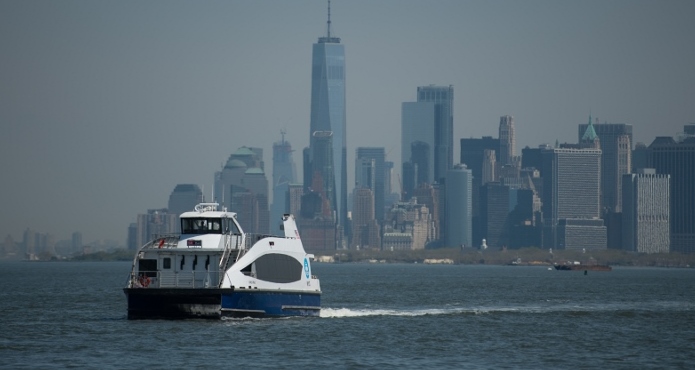New York City will spend an additional $300 million to double the year-old NYC Ferry fleet, with annual ridership now projected to approach 9 million by 2023, Mayor Bill de Blasio said.
Already the city is adding three new 350-passenger passenger vessels this summer to augment the original fleet of 16 Incat Crowther-designed 150-passenger catamarans, with three more to be delivered by shipyard Metal Shark, Franklin, La., in 2019.
Meanwhile, operator NYC Ferry by Hornblower will also charter up to eight additional vessels with capacities of 200 to 500 passengers to help with summer crowds in the coming months, de Blasio and other officials said at a May 3 press conference at the ferry terminal in the bay Ridge section of Brooklyn.
The public ferry, subsidized at $6.60 per rider to achieve the same $2.75 fare as the city subway, was an immediate success in spring and summer 2017 – so much that within weeks the system had problems with crowding and delays. Along with the additional charted vessels, operators are increasing service frequency to 20 to 30 minutes, adding capacity and a new rush hour and weekend express service on the popular Rockaway route, and boosting staffing at landings to assist passengers with queuing and boarding.

Capt. Constansa Torrejon-Reyes was among NYC Ferry workers when Mayor Bill de Blasio announced plans to double the system capacity by 2023. Michael Appleton/Mayoral Photography Office.
De Blasio and James Patchett, president of the New York Economic Development Corporation that oversees the ferry system, acknowledged they underestimated the public appeal of new ferries linking the outer boroughs with Manhattan. Based on a 2013 EDC study, city officials anticipated around 4.6 million riders a year, said Patchett.
“We’ve obviously blown those projections out of the water. So that means we need to upsize the fleet in order to serve what is expected to be essentially double the level of ridership we ever projected,” said Patchett.
“The exact number of vessels we’ll purchase is a little bit up in the air because it will depend on the exact mix of a 150-person vessels versus 350-person vessels,” he said. “We’re still in negotiations with the shipyards so we don’t want to show our hand too much but the bottom line is we’re going to be more than doubling the capacity of the city, and we’re going to be adding a lot more vessels including those larger vessels to serve more passengers during busy times.”
Plans also call for adding more space at the Wall Street/Pier 11 and 34th Street landings, which Patchett called “one of the biggest constraints on the capacity of the system.” Adding more vessels will also require a second home port location for basing and maintain ferries, he said.
Patchett and the mayor parried media questions about whether more funding for the NYC Ferry – a signature project for de Blasio, who insists everyday New Yorkers deserve more commuting options – is the right policy, given problems on subway and bus lines that carry millions more commuters.
Patchett and other officials said the ferry has been a huge improvement for residents in neighborhoods it serves like Rockaway and Bay Ridge, where work in Manhattan is a long commute by bus or rail.
“My experience has been that people, passengers are saving up to an hour of commuting time…so that is an additional hour either at the office, an additional – or an hour less of childcare, or however you want to use that time,” said Patchett. “That’s a really big economic impact in people’s life.”
One reporter asked de Blasio “how do you justify sinking more and more money into boats while there’s a lot of people who can’t take the train?”
De Blasio defended the ferry saying “adding transportation options for millions of New Yorkers is a good thing” and he would continue to push for other funding fixes to transit problems.
“We’ve got to be able to do more than one thing at a time. And look if you think about the alternative which is let’s – okay, so you can say, well, let’s not develop ferry service, let’s not have this option for the future,” said de Blasio.
“I think we’ll regret that. I think we’ll regret it when we’re at 9 million people. I think we’ll regret it as the subways and the highways get more and more crowded. I think we certainly would regret it if, God forbid, we were ever dealing with emergencies where we needed other ways to get around, because this is going to be one of the ways that works even in bad times. And we saw that after (hurricane) Sandy.
“So, I’m convinced this is a great investment.”





